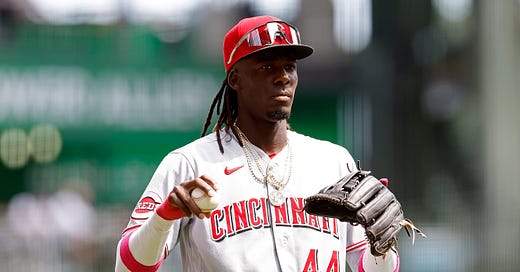I often wait until everything lines up before writing an article.
I want to have the perfect topic, with proper research conducted, a clear idea of my main thesis, and creative ideas for intros/conclusions.
Today isn’t one of those posts.
Elly De La Cruz is a polarizing player, particularly in fantasy baseball circles. Just last summer he was being drafted inside the first round of Underdog Fantasy’s midseason best ball tournament.
This, to me, was absurd — yet Elly’s second half face plant hasn’t slowed the enthusiasm. Through 52 NFBC drafts this offseason, De La Cruz is being taken, on average, as the 20th player off draft boards.
(At Underdog, he’s currently available for a more reasonable price of an early-to-mid 4th-round pick, though his value there is dampened by the over-saturation of infielders and the fact his stolen base upside carries less weights in a points-based scoring system.)
I remain undecided on how I want to play Elly in 2024 redraft leagues. At minimum, I’ll have some shares. I’m not taking a hard fade on a player with 40/70 upside who hits in baseball’s most friendly offensive environment.
But do I want to be aggressively in on Elly at these prices? That’s the key question I’ll be attempting to answer this winter. I’ve yet to decide, but I wanted to share some findings after digging into his profile over Thanksgiving weekend.
FOMO In Fantasy Sports
I wound up with Elly in 50% of my redraft leagues last summer, but instead of celebrating the ones where I was able to land him, I found myself agonizing over the spots where I didn’t have him.
That’s how electric the start of his big league career was.
It seemed as if every night he set a new exit velocity record, or at least stole a couple of bases. From his call-up in early June through the end of the first half he slashed .325/.363/.524 (133 wRC+) while successfully stealing on 16 of 18 attempts.
The second half was a lot less fun — .191/.271/.355 (62 wRC+), though he still popped 9 homers and swiped 19 bags.
Grounders + Swing Decisions
So much of the early discourse surrounding Elly had to do with his ground ball rate. At one point it appeared as if he was making the necessary adjustments early in his big league career, but by the end of 2023 things had unfortunately reversed course:
The saving grace, in the eyes of many, is that Elly still made improvements under the hood, even amid his struggles. His chase rate on pitches outside the zone decreased throughout his time with the Reds:
This brings me to the core of what I want to discuss today, because I love chase rate as a stat, but I’m seeing it addressed without proper context lately.
It’s one thing to chase less while still swinging at pitches inside the zone at the same rate. That’s actually ideal, and it’s very tough to do. It isn’t what we saw from Elly throughout 2023:
Instead, Elly’s declining chase rate was fueled by a willingness to stop swinging altogether.
His September 54.5 Z-swing% would’ve been tied for the lowest in the majors had he maintained it for a full season. When you can hit the ball as hard and as far as Elly De La Cruz can, we don’t want to see that few swings inside the strike zone.
Some hitters can make a similar approach work, such as Kyle Schwarber and Juan Soto, but even they aren’t swinging that infrequently at strikes.
My read on this is that Elly arrived to the majors and quickly got off to a hot start, which fueled an (understandable) desire to swing more. When the struggles kicked in it appears as if he intentionally became more selective, but I think he went too far with that approach.
Finding the optimal balance between swing-don’t swing is going to be the biggest challenge for De La Cruz, not just for 2024 but for the next several years of his career.
Additional Thoughts:
Elly increased his walk rate in September, but it was also his lowest monthly ISO.
When he first came up he had his best production, but also his highest BABIP and HR/FB%.
His struggles down the stretch doesn’t mean he’s bad. He might’ve just run out of time to make adjustments.







